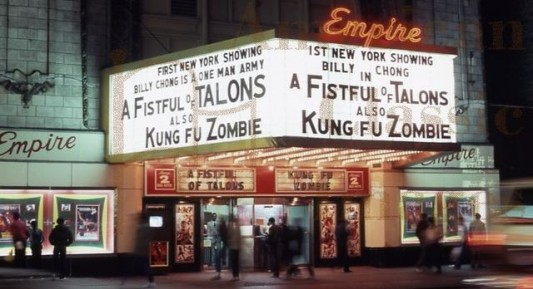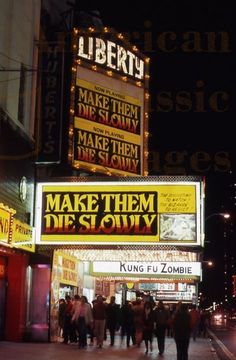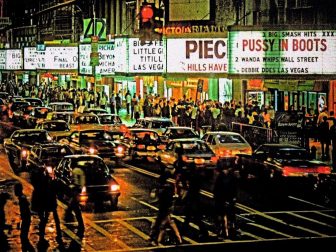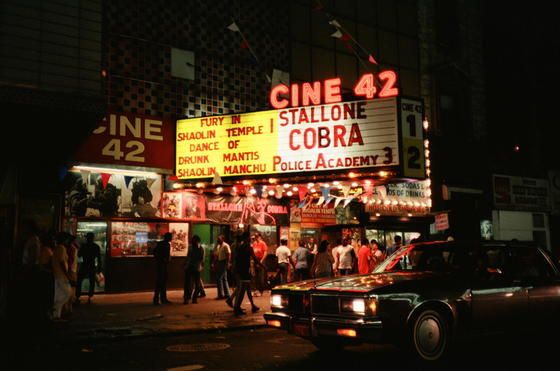 Everyone, it seems, loves grindhouse cinema. Such movies were popularized by Quentin Tarantino and Robert Rodriguez’s GRINDHOUSE, which spawned an apparently never-ending sub-genre of campy exploitation flicks (see MACHETE, HOBO WITH A SHOTGUN, DEAR GOD NO!, etc). That’s in addition to the 2010 documentary AMERICAN GRINDHOUSE, the magazine GRINDHOUSE PURGATORY and the many websites and DVD compilations devoted to all things Grindhouse. There’s even a Grindhouse burger joint.
Everyone, it seems, loves grindhouse cinema. Such movies were popularized by Quentin Tarantino and Robert Rodriguez’s GRINDHOUSE, which spawned an apparently never-ending sub-genre of campy exploitation flicks (see MACHETE, HOBO WITH A SHOTGUN, DEAR GOD NO!, etc). That’s in addition to the 2010 documentary AMERICAN GRINDHOUSE, the magazine GRINDHOUSE PURGATORY and the many websites and DVD compilations devoted to all things Grindhouse. There’s even a Grindhouse burger joint.
For those who don’t know, grindhouses were skuzzy big city venues that played exploitation movies. The most famous of those venues lined the Deuce, located in the Times Square section of 42nd Street in New York City. It was the Deuce that bequeathed the term Grindhouse, as its venues were former burlesque theaters specializing in so-called “bump ‘n grind” dancing.
Grindhouses thrived in the 1960s, 70s and 80s, with the end coming in the early nineties. The final film to play the Deuce, according to grindhouse authority Bill Landis, was 1993’s FALLING DOWN at the Liberty, the last remaining Deuce venue. Its closure helped facilitate the area’s transformation into the Disneyfied tourist playground it is today.
Prior to the 2007 release of GRINDHOUSE, few outside the cult movie set knew about grindhouse cinema or the Deuce. Quentin  Tarantino had previously attempted to popularize seventies-era grindhouse moviemaking with his short-lived Rolling Thunder Pictures, which re-released the seventies-sploitation classics THE MIGHTY PEKING MAN, SWITCHBLADE SISTERS and DETROIT 9000—to little success. GRINDHOUSE, let’s not forget, was itself a box office flop, due largely to the fact that few understood its title (a friend of mine believed it was about deranged slaughterhouse workers grinding people up) or overall format (with double features being a thing of the past). The film had a sizeable impact nonetheless, as evinced by the grindhouse chic that followed in its wake.
Tarantino had previously attempted to popularize seventies-era grindhouse moviemaking with his short-lived Rolling Thunder Pictures, which re-released the seventies-sploitation classics THE MIGHTY PEKING MAN, SWITCHBLADE SISTERS and DETROIT 9000—to little success. GRINDHOUSE, let’s not forget, was itself a box office flop, due largely to the fact that few understood its title (a friend of mine believed it was about deranged slaughterhouse workers grinding people up) or overall format (with double features being a thing of the past). The film had a sizeable impact nonetheless, as evinced by the grindhouse chic that followed in its wake.
Inevitably, the newfound popularity of such fare has spawned a wave of grindhouse nostalgia, with seemingly everyone reminiscing about the glory days of the Deuce. I believe that unless the person doing the reminiscing a). is over 50, and b). once lived in close proximity to a big city you can categorically dismiss those claims.
What about my grindhouse credentials, you ask? Well, having grown up in the Los Angeles area I wasn’t far from the Hollywood grindhouse scene where Quentin Tarantino reportedly got his trash movie education, yet by the time I came of age nearly all those theaters were gone. (I recall heading to a theater on Wilshire Boulevard to see a movie in late 1991, only to find the place being closed down)*
Genuine 42nd Street nostalgia can be found in pioneering cult movie zines like Gore Gazette, Slimetime and Sleazoid Express. All were written/published by guys who lived in the New York area and knew the territory, and (most importantly) actually reported on the grindhouse scene as it was happening.
The Bill Landis authored Sleazoid Express early eighties zine and 2002 book remain the most authoritative resources on the subject. Landis claimed to have “memorized every inch of Times Square’s topography” and worked in many Deuce theaters during the 1970s and 80s. In Sleazoid Express he astutely chronicled the movies that played the Deuce, as well as the exploits of the assorted perverts,  junkies, petty thieves and social deviants that comprised the grindhouse scene, where “muggings and bloody needles were the order of the day.” It helped, of course, that Bill Landis was himself a prolific drug user and reckless thrill seeker, a far cry from the wide eyed-innocent-in-Babylon he made himself out to be (in the SLEAZOID EXPRESS book, that is; much of his writing in the Sleazoid zine was, according to writer Stephen Thrower, “notable more as gonzo reports from the brink of amphetamine psychosis than as film journalism per se”).
junkies, petty thieves and social deviants that comprised the grindhouse scene, where “muggings and bloody needles were the order of the day.” It helped, of course, that Bill Landis was himself a prolific drug user and reckless thrill seeker, a far cry from the wide eyed-innocent-in-Babylon he made himself out to be (in the SLEAZOID EXPRESS book, that is; much of his writing in the Sleazoid zine was, according to writer Stephen Thrower, “notable more as gonzo reports from the brink of amphetamine psychosis than as film journalism per se”).
Yet the allure of the grindhouse is undeniable, especially to those of us who grew up attending sanitized suburban multiplexes. The danger that suffused the grindhouse scene only enhances that allure, even if that danger was downright life-threatening on occasion.
Harlan Ellison’s 1977 essay “The Three Most Important Things in Life” contains a vivid description of an early seventies movie crawl on the Deuce, during which Ellison and a pal took in “the kung-fu operas, the porn jobs, the superfly stomp and paddy flicks…One after another till our eyes turn to poached eggs, staggering from theater to theater like refugees from a Macao opium den.” Sounds weirdly alluring, though Ellison’s descriptions of seeing a man thrown to his death from a theater balcony and the mangled corpse are decidedly less so: “The diver lay across the back of a shattered seat. He was bent double. Stomach up. His spine was broken. He didn’t move.”
Nearly as appalling is the double feature Ellison claims was playing in the theater: FEAR IS THE KEY and SAVE THE TIGER, two justifiably forgotten early seventies snooze-fests. A similar sense of dismay is evoked by a popular photo of the Deuce reproduced below, showing a theater playing the Sly Stallone bummer COBRA. Based on what I’ve read, FEAR IS THE KEY, SAVE THE TIGER and COBRA wouldn’t seem to be optimum grindhouse fare, although I suspect that in reality they very likely were.
A frequent complaint about the Quentin Tarantino DEATH PROOF segment of GRINDHOUSE is that it’s an overlong yack fest propped  up by three tremendous action/shock sequences. I don’t entirely disagree with that sentiment (particularly in the extended DVD version), but it seems to me that Tarantino was following a precedent set by quite a few grindhouse movies, which tended to be made up of long stretches of boredom with short bursts of violence and/or sex to keep us awake. Indeed, working my way through the grindhouse lexicon on video and DVD it’s become increasingly clear that this cut-rate aesthetic was the norm, while transcendent exploitation fare like SHOGUN ASSASSIN, THE STREETFIGHTER and THE CANDY SNATCHERS, films that are often brought up when discussing grindhouse product, were the exceptions.
up by three tremendous action/shock sequences. I don’t entirely disagree with that sentiment (particularly in the extended DVD version), but it seems to me that Tarantino was following a precedent set by quite a few grindhouse movies, which tended to be made up of long stretches of boredom with short bursts of violence and/or sex to keep us awake. Indeed, working my way through the grindhouse lexicon on video and DVD it’s become increasingly clear that this cut-rate aesthetic was the norm, while transcendent exploitation fare like SHOGUN ASSASSIN, THE STREETFIGHTER and THE CANDY SNATCHERS, films that are often brought up when discussing grindhouse product, were the exceptions.
So keep on seeing the grindhouse DVDs, reading the grindhouse books and magazines, and dreaming about the wild world of grindhouse cinema, with its on and off-screen thrills. Just keep in mind that the reality was likely far closer to Bill Landis’ description of how at the end of a typical grindhouse screening “the audience would groan angrily, head for the candy stand, smoke a joint, complain to other audience members, then settle in for the tried-and-true second or third feature.”
*For the record, in my lifetime I’ve had exactly two grindhouse experiences. The first was at age 13, when I snuck into a San Diego dive to catch a double bill of THE HITCHER and A NIGHTMARE ON ELM STREET 2, and the second occurred a year or so later, when I saw FULL METAL JACKET at a Times Square theater. The Deuce they weren’t, but in both instances the behavior of the slobs in the theater around me was consistent with the descriptions by Bill Landis and others of typical grindhouse patrons.
